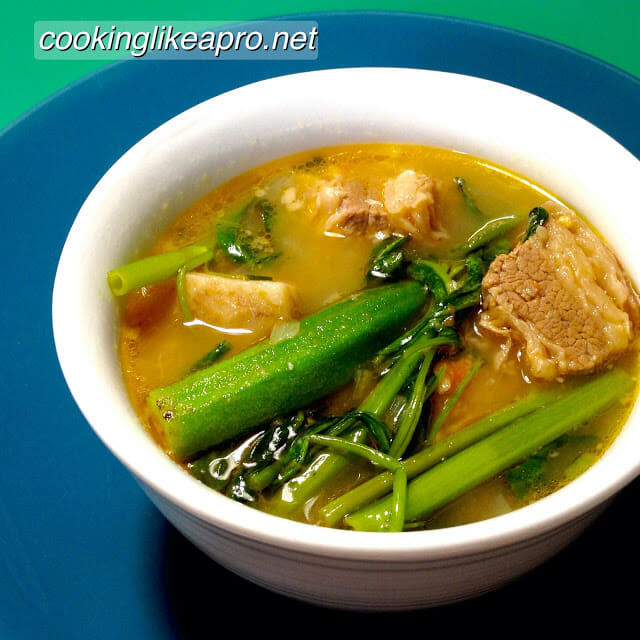Sinigang is one of the Filipino classic dishes. It’s a sour soup of many variants. It may be of beef, pork, fish or chicken. For this post, we’ll be cooking sinigang with beef (baka). And for this kind of sinigang, guava fruit (bayabas) is the perfect match in making the soup.

On a personal note, sinigang na baka is not all sour. There’s a bit of sweetness to it, too. Its soup is heavier than that of sinigang na baboy (pork); perhaps because of the flesh of the guava fruit which adds to the thickness of the dish. It does make a lot of sense that the guava fruit makes this beef dish rich and tasty because it is a sweet fruit (when eaten) and packed with Vitamic C (acid) at the same time.
Honestly though, while I know from menus in Filipino restaurants and dried packets of sinigang mixes that guava may be used in cooking sinigang, I haven’t really tried cooking with guava until my hubby introduced me to it. I’d say this dish is very easy to cook. You just need to have patience as it takes time to tenderize the meat. The procedure is very similar with the other variations of the sinigang, with just a few added steps.

Sinigang na Baka sa Bayabas
Ingredients
- 1 kh Beef spare ribs 1(or any part, preferably with bones)
- 5 pcs Whole tomatoes uncut
- 6-8 cloves Garlic bruised
- 3 pcs Onions chopped
- Okra
- Kangkong swamp cabbage, water spinach
- Sitaw string beans - optional
- Gabi taro - optional
- 3-5 pcs Guava ideally not fully ripened
- 2 tbsp Salt
- Fish sauce to taste
- 1.5-2 ltrs Water (Depends on the part of beef, the lesser the bones the fewer the water)
- Long green chili optional but desired
Instructions
- Put the beef in a pot with water and salt.
- Scoop out the scum after 10 minutes or just when the water is about to boil.
- Put in the garlic, onions, tomatoes and guava.
- Let it boil under low heat for about an hour.
- When the meat is tender, add in the vegetables.
- Season with fish sauce to taste.
- When the vegetables change colour into a more vibrant green, they are cooked.
- Put the long green chili on top.
- Turn of the heat and let it sit for several minutes.
- Serve with hot rice.
Video
Notes
- No need to cut through the tomatoes and guava. Let them soften and be in one with the dish as it cooks.
- Depending on the thickness of the meat and the heat, you may need to extend the hour to 10-20 minutes. In my case, I don’t mind the wait because the final product would be meat off the bones tender. Also, avoid opening the pot every now and even. If you feel the need to stir, do so after 30 minutes and that’s it. Leave the dish and let it cook.
- I hope I gave you a very clear idea on how to cook sinigang na baka sa bayabas. Remember me when you cook!
- Read more Filipino Recipes
About Sinigang na Baka sa Bayabas

Sinigang, a beloved Filipino soup, is known for its thick and creamy texture, often made with beef, water spinach, and fresh guavas. Ideal for rainy days, this comforting and healthy meal uses beef shank, slow-cooked to perfection, with options to substitute pork, chicken, or fish.
The broth, a key element of sinigang, combines tamarind, tomatoes, garlic, and onions, with tarocorms adding starch. Green long peppers contribute a tangy flavor, while miso can substitute for meat. In the variant “sinigang na baka sa bayabas,” beef is rubbed with salt, cooked, and joined by guavas and courgettes. The sachet of sinigang na bayabas enhances the flavors, creating a dish best enjoyed on rainy days.
Balancing its sourness, guava serves as the tamarind base, complemented by a sweet component. Sinigang pairs excellently with steamed rice or meat, often served as a side dish with grilled chicken, making it a popular staple across the country.

Traditional sinigang involves simmering beef shank until the broth thickens, enriched by fresh guavas, water spinach, and tamarind powder. Despite the challenge of preparing a gambay-styled dish, the result is well worth the effort.
The classic Filipino soup, whether made with beef, pork, fish, or chicken, relies on the traditional combination of pork, guavas, and guavas for its distinctive flavor. The thickened broth, enriched with tamarind, garlic, onions, and kangkong leaves, is best prepared by first cooking the meat until tender.
Sinigang can also incorporate tomato sauce and various fruits and vegetables for a unique taste. The sinigang na baka sa bayabas variant, a tamarind-based soup, allows for flexibility with beef, pork, or fish, each prepared with slight variations. Whether served as a main course with rice and spicy fish sauce or reheated for up to three days, this beef sinigang with guavas remains a delicious and versatile Filipino dish.

Serving Suggestions for Sinigang Na Baka Sa Bayabas
This guava beef sinigang is delicious on its own, but here are some serving ideas:
- Serve as a starter soup before a main meal
- Ladle into bowls with steamed rice for a satisfying one-pot meal
- Garnish with sliced green onions, chili peppers, or calamansi lime
- Pair with a side of grilled or fried fish
- Add a dollop of shrimp paste or fish sauce as a salty, umami dipping sauce
- Squeeze some calamansi juice over the soup for an extra tangy kick
Storage and Reheating Tips

Like many soups, Sinigang Na Baka Sa Bayabas tastes even better the next day once the flavors have had time to develop. Here are some tips:
- Let cool completely before transferring to an airtight container
- Refrigerate for up to 3 days
- Reheat gently on the stovetop or in the microwave. How To Reheat Food Without A Microwave: If you prefer alternative methods, consider reheating on the stovetop using low heat or employing other kitchen appliances like an oven or toaster oven. These methods can help maintain the dish’s original texture and flavor without the use of a microwave.
- Add a splash of water if the soup is too thick
- Taste and adjust seasoning if needed
Some Fun Variations to Try
One of the great things about Sinigang is how versatile it is. You can customize it with different meats or seafood, veggies, and souring agents. After enjoying this guava version, here are some other variations I want to try:
- Sinigang Na Baboy (pork)
- Sinigang Na Hipon (shrimp)
- Sinigang Na Bangus (milkfish)
- Sinigang with kamias (bilimbi)
- Sinigang with radish greens
- Tofu Sinigang for a meatless version
The possibilities are endless! I love how this soup allows me to get creative in the kitchen.
Why I Fell in Love with This Traditional Filipino Dish
Cooking this delightful Filipino soup was an amazing cultural experience. From the unique ingredients to the tasty blend of sour and savory flavors, it was a joy to prepare and eat.
I love that it’s a flexible one-pot meal. You can add any vegetables you have on hand or tailor the protein to your taste. It’s simple, nourishing comfort food perfect for any time of year.
Sinigang Na Baka Sa Bayabas has easily become one of my favorite soups. I can’t wait to continue exploring the many varieties of this iconic Filipino dish. Each one offers a chance to savor new flavors and ingredients.
So if you’re a fellow foodie in search of something new, I highly recommend giving this tasty recipe a try! Let me know if you have a favorite sinigang recipe I should add to my list. I’m always down for an exciting culinary adventure!






